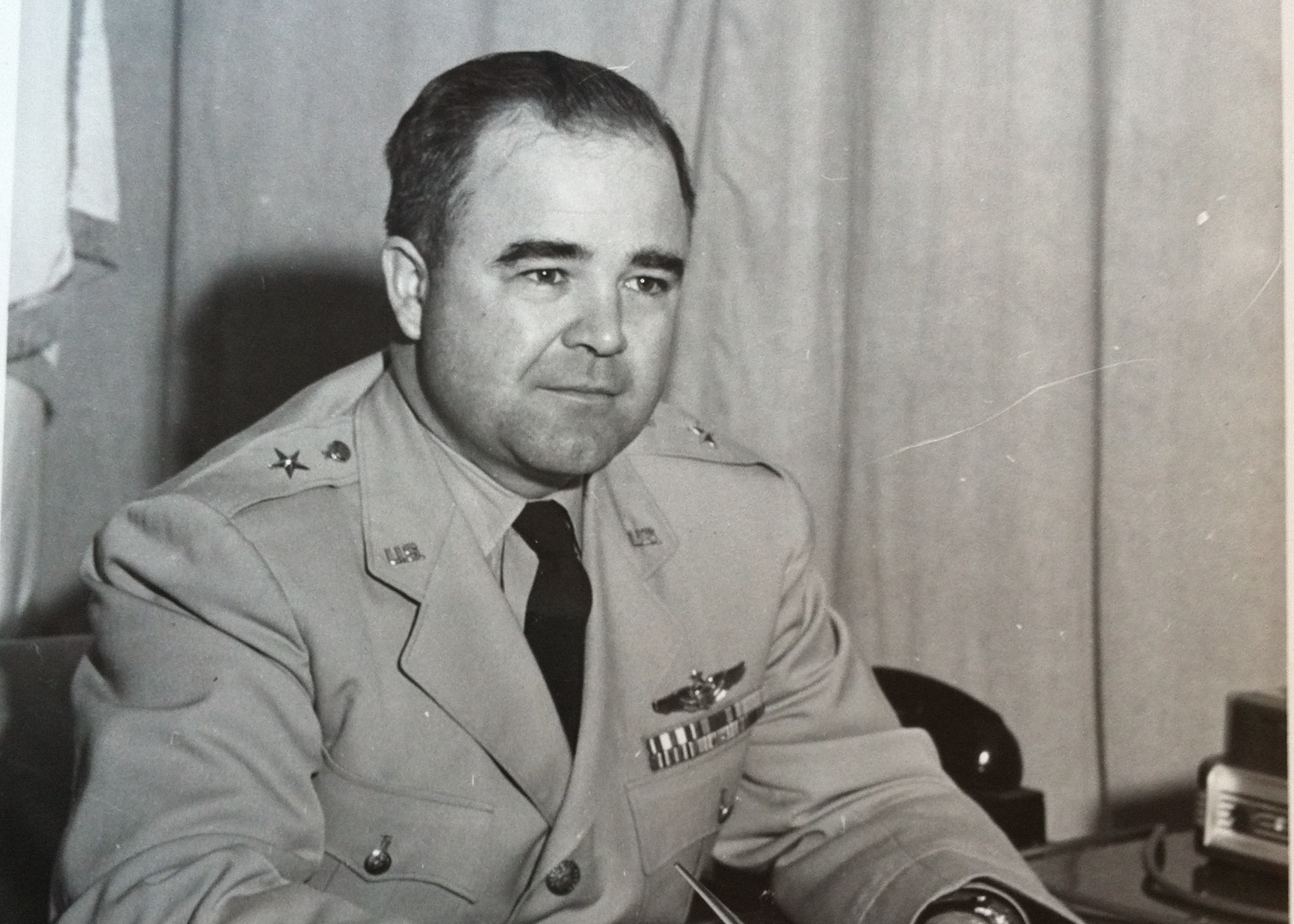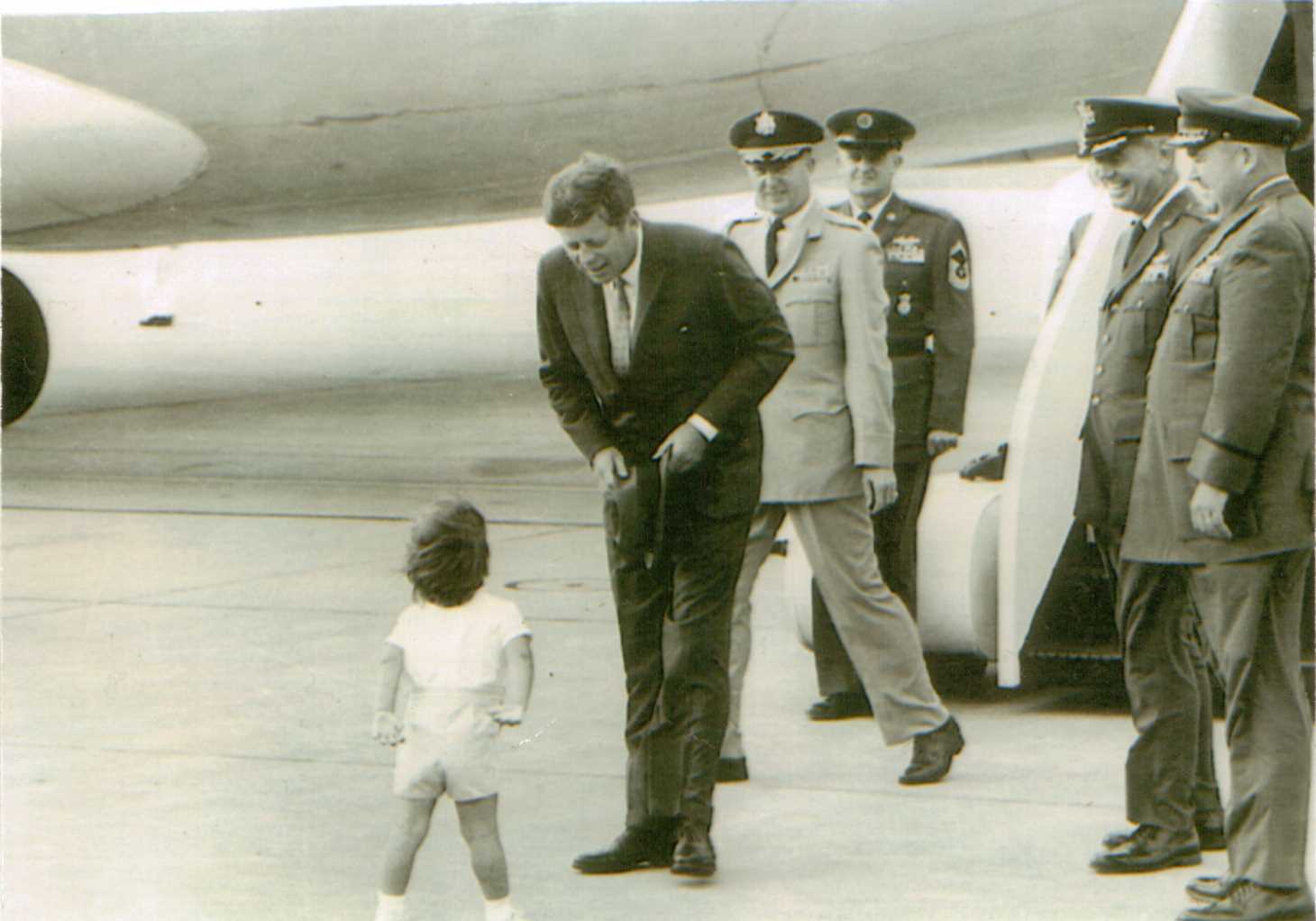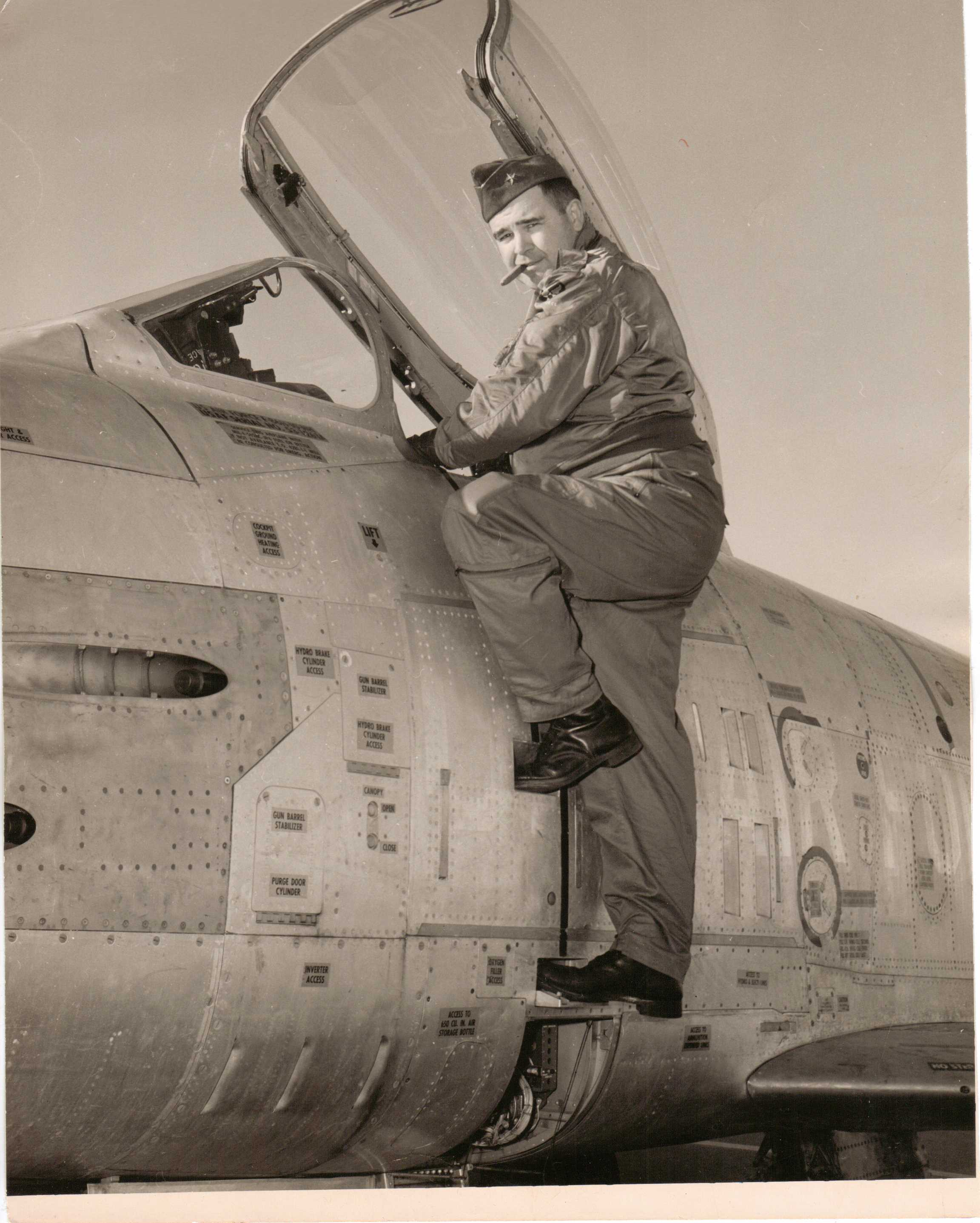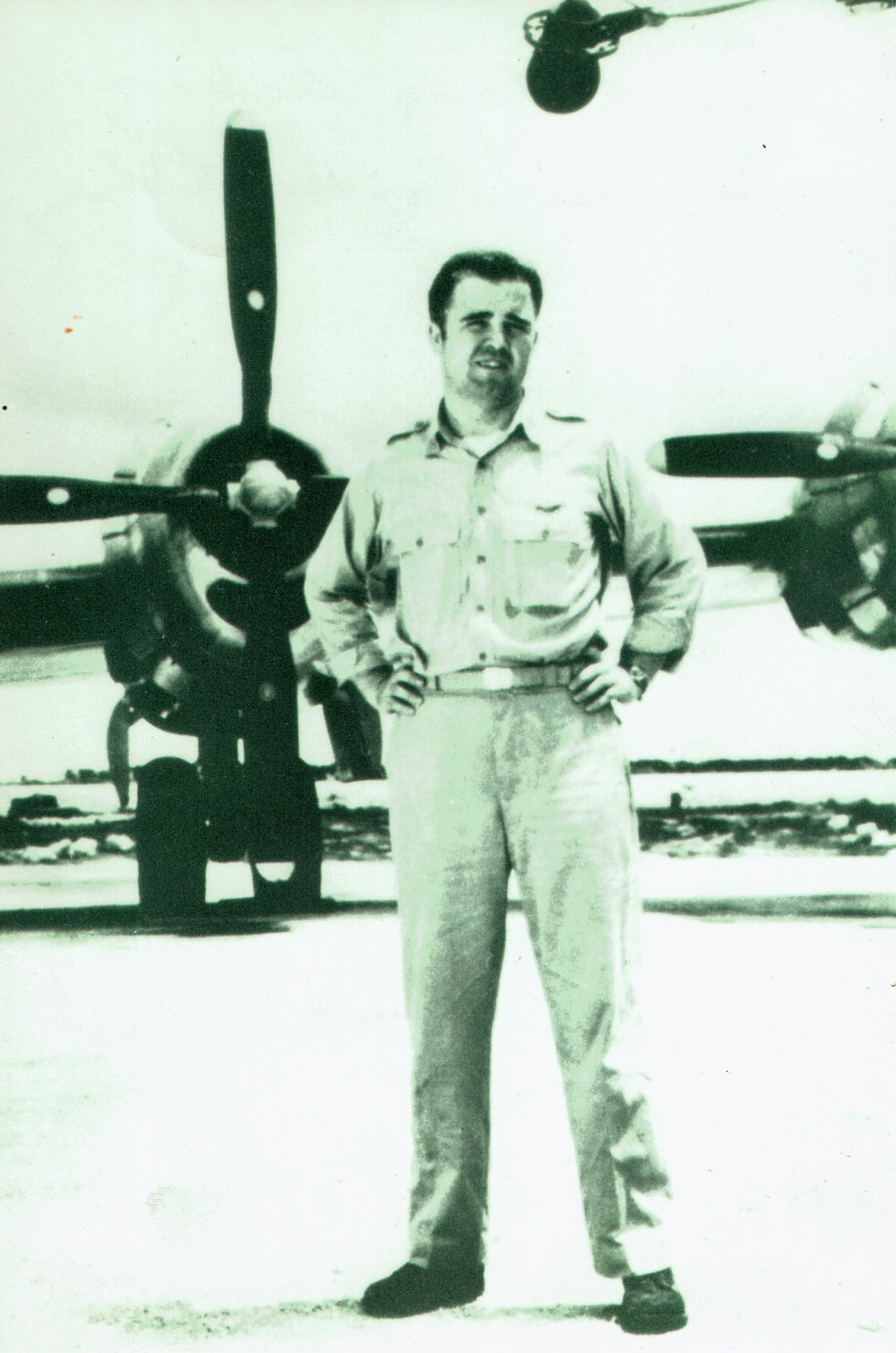- Mass. Air National Guard & the Berlin Wall Crisis
- JFK, Otis AFB, and Air Force One
- A Mission to Preserve History
Immediately after World War II, Dad joined what was then the US Army Air Forces Reserve Unit at Hanscom Field in Massachusetts, which shortly thereafter was reconstituted as the Massachusetts Air National Guard. He was first appointed as an Air Guardsman by Massachusetts Governor Robert F. Bradford and advanced in rank from Major at age 25 to Brigadier General at age 36, the youngest one-star general in the country at that time. After starting out as the squadron operations officer with P-47s at Logan Airport, by 1958 he had moved up the ranks to become the Wing Commander of the 102nd Fighter Wing, which eventually moved from Logan Airport to Otis Air Force Base on Cape Cod.
As the Berlin Crisis developed in the summer of 1961 the 102nd Tactical Fighter Wing of the Massachusetts Air National Guard received notice that it was to be activated for Federal Service on September 1st. From that date forward, the Wing’s three squadrons, comprised of the 101st [Boston], 131st [Westfield, MA], and 138th [Syracuse, NY] began preparations for deployment from their respective home bases. On October 28th 1961, the three F-86H squadrons rendezvoused at Loring AFB in Maine to commence their deployment to Phalsbourg Air Base in France. Although Dad had been “checked out” and qualified to fly the F-86, his position as Wing Commander with its attendant responsibilities did not normally require him to maintain current proficiency in the aircraft. Upon receipt of the deployment orders, he immediately set about to update his qualifications in the aircraft in order to personally lead the three squadrons across the Atlantic.
Even more challenging, this deployment had no precedent. It was the first time in US history that such a large group of aircraft from the Air National Guard had been called to active duty on a “trans-lant” or a cross-Atlantic mission, and it was remarkable for many reasons: the F-86 did not have aerial re-fueling capability and there was no air traffic control radar for over-ocean or Arctic area flight segments. Therefore, the deployment flight plan was via the “Pine Tree Route” as follows:
From the rendezvous point at Loring AFB on October 28, 1961, the three F-86 squadrons, consisting of a total of 78 aircraft departed for Phalsbourg on the following day in flights of four with overnight stops at Goose Bay AB, Labrador, Sondrestrom AB, Greenland, Keflavic NAS, Iceland, and Prestwick AB, Scotland. Originally, no overnight had been planned at Prestwick with the planes pushing through to Phalsbourg. However, only the first two flights made it into Phalsbourg due to deteriorating weather conditions. The remainder of the fighter stream was held at Prestwick and departed the following day, arriving in Phalsbourg on Thursday, November 2, 1961. As mentioned above, the lack of air traffic control radar plus over-ocean as well as Arctic area navigation required 15 minute separation between each flight of four aircraft; and therefore it took nearly five hours to move all 78 fighters from point A to point B. The safe movement of 78 aircraft in one stream far exceeded the previous Air Force record of a 24 aircraft movement. This was a feather in the cap of the Air Guard and specifically the 102nd Wing.[1]
With Dad’s leadership and without a single incident, the 102nd was recognized for accomplishing this unique feat as a “first” in the history of the US Air Force. This “rapid, safe, and precedent-shattering move to Europe was hailed by all observers”[2] and resulted in accolades from numerous USAF hierarchy and US Secretary of Defense Robert McNamara who proclaimed the Wing’s relocation as a “magnificent performance . . . that made military history.”[3]
Arriving in Phalsbourg, and despite all the acclaim, the Guardsmen were disheartened as they landed at a “disbursed operations base” – meaning it was not a functional air base at that time. Although it was supposed to be maintained under “caretaker status” in accordance with NATO agreements, Dad and his arriving troops found themselves without sufficient provisions, billets, office furniture, and telephone lines. Troops had to walk several miles to the mess hall because of insufficient ground transportation.
Springing into action, Dad and his staff managed to cajole local help to get the airfield and support facilities up to some semblance of standard operational status, which daringly included renting non-government local buses from the city of Strasbourg and autos from Hertz, as well as borrowing a few vehicles from a nearby Canadian Air Force Base, to meet the transportation shortage. Two weeks after they landed in Phalsbourg, as they scrambled for beds, chairs, vehicles, and telephones, the notorious General Curtis LeMay arrived for an inspection.
The last time Dad had met Gen. LeMay was on August 10, 1945, one day after he returned to Tinian from Nagasaki. After piloting Bock’s Car and avoiding a potentially disastrous landing on the American-held Japanese island of Okinawa, Dad was ordered to report to then-Major General Curtis LeMay in Guam. Unlike the congratulatory handshake and words of praise from Gen. Jimmy Doolittle in Okinawa and those of several command staff in Tinian, Dad would never shake off the cold and terse reception he received from Major General LeMay in Guam.
Although only peripherally involved in the atomic missions, Le May had taken over the 21st Bomber Command in the Mariana Islands in January 1945 and was responsible for all conventional air operations against Japan. Nicknamed “Old Iron Pants” for his uncompromising view of performance of duty, he was working from his Quonset hut on Guam when Dad walked in. As family legend goes, LeMay sat stiffly at his desk, chewed on his cigar, and reviewed a few papers. Without looking up from his desk, he said to Dad, “You missed your primary target, didn’t you, Major?” Disheveled, sleep-deprived, and still somewhat traumatized from the atomic mission only one day before, but a military man to the core, Dad simply replied, “Yes, Sir.” LeMay paused and — with cigar still clenched in his teeth and eyes still glued to his paperwork — responded, “Get out of my office.”[4]
Now in Phalsbourg, France 16 years later, Dad prepared to meet the four star-General Curtis LeMay, who swiftly rose up the ranks after WW II to become Chief of Staff of the United States Air Force, for an inspection. LeMay loathed the idea of using ANG units for this Berlin Wall Crisis because they were subject to control by their respective states, and LeMay only wanted units that he could command.[5] However, once they were federalized and under his lead, he capitulated. He also realized that this crisis reflected a “Cold War” which was very different from the aerial supremacy he was accustomed to in WW II — and his relationship with his boss, Secretary of Defense Robert McNamara, was tenuous, at best. LeMay had no choice but to fly to Phalsbourg and find out more about these renegade ANG units that McNamara had deployed to Phalsbourg.
Dad was never one to hold a grudge, although he probably still chafed thinking about the dispassionate and poker-faced LeMay in Guam. Nonetheless, as a welcome peace offering, Dad tendered a box of fine Cuban cigars which were contraband in the United States but not illegal in France. LeMay inquired, “Where did you get these, Charlie?” Dad winked, “Don’t ask, Sir.”
With stogies in hand, and the ice between them safely defrosted, the two Generals toured the scruffy base in Phalsbourg with their command staff. When they were done, LeMay turned to his Deputy and asked who was responsible for not maintaining the base for active duty? The Deputy replied, “The Commander of the 17th Air Force in Europe, Sir.” Quickly reverting to his Guam-like demeanor, LeMay had only two words in response: “Fire him.”
Within a week or two of arriving at Phalsbourg, Dad’s unit was flying sorties and maintaining a strong U.S. presence close to Berlin. The ANG success in this Cold War endeavor — where the Guard’s presence had been used to preserve peace rather than engage in aerial combat — was memorialized by President John F. Kennedy who stated:
“I know I speak for all our countrymen in expressing an appreciation to all those who served under the adverse conditions of living in camps and being taken away from their families. The willingness of the great majority of all of them to do this uncomplainingly, I think, should be an inspiration to every American. . . . Mission accomplished. You can return to your civilian pursuits with pride in your hearts.”[6]
In July 1962, after successfully completing their mission, the Air National Guardsmen returned home to their respective bases, and for the most part, their lives as weekend warriors.
_____________________________________________________________________________________________________________________________________
[1] Mundo, Albert (Capt., Ret., Flight Commander, MA ANG) Personal correspondence, 2017
[2] Kenneally, James J., (Col., Ret., MA ANG): Minutemen in a Micro-chip Age, a History of the Massachusetts Air National Guard (undated), p. 33
[3] Ibid.
[4] Dad often used this story as a teachable moment with his children. “No matter where you go in life,” he’d say, “and whatever path you take, there’ll always be hard noses like LeMay. But try to find and cherish the Jimmy Doolittles of the world who aren’t afraid to shake your hand for a job well done.”
[5] Tillman, B., LeMay: Lessons in Leadership (2007), p. 138
[6] Kenneally, op. cit., p. 40
For Dad, weekend warrior-ship meant active duty at Otis Air Force Base on Cape Cod. It was at Otis that Dad renewed his friendship with then John F. Kennedy, who flew in and out of the area when visiting his home in Hyannisport. Later, upon assuming the Presidency, JFK would use Otis as his primary summer air base for Air Force One.
One insightful tale comes to light during the annual “summer camp” of 1961 which was JFK’s first summer in office. Dad — who at 6’2” and 245 lbs. had gone from a svelte USAF flight suit to needing extra fabric to accommodate his expanding waistline — lined up his troops in Wing formation on the west ramp to greet the Commander-in-Chief and his entourage. There were a few F-86s lined up there as well — all shiny and emblazoned with the bright green shamrock insignia depicting the 101st Fighter Squadron of the “Irish Air Force” (as they were unofficially known).
As Captain Mundo tells the story:
I was close to the front ranks and as Kennedy came down the steps of Air Force One and walked over to Charlie to shake his hand, I distinctly recall him saying: “For Christ sake, Charlie, don’t tell me you can still fit into those little airplanes” [F-86s]. Of course his reference was to Charlie’s girth at the time, but it is significant because when we deployed to Europe, the ’86s were equipped with not only the regular seat pack life raft but also an arctic survival kit on top of that which tended to minimize the room between the top of the pilot’s helmet and the cockpit canopy. Additionally we were wearing the water survival [“poopy”] suits which, along with the under arm life vests and back pack parachute, really crowded you in the cockpit. Free space was at a minimum for an average, maybe 5’10” 175 pound pilot. Indeed, anyone over that height found themselves sitting with their head slightly tilted forward. So Charlie had to really be shoe-horned into the cockpit. All the more remarkable was that despite his relatively low flying hours in the F-86 coupled with this discomfort were his inherent flying abilities and leadership capabilities in leading this massive aircraft movement on the deployment to Europe.[1]
Otis AFB offered us Sweeney children some truly significant and historic memories. This is where we had many magical moments visiting Air Force One and stealing life savers and cigarettes with the Presidential Seal on them. Tragically, this is also where we were in summer residence when Jacqueline delivered her third-child, Patrick Bouvier Kennedy, in August, 1963. After a premature delivery at the Otis hospital, Dad helped to clear the skies when Marine One brought the President on his emergency trip. Patrick had to be transported to the ICU at Children’s Hospital in Boston for a fatal condition called hyaline membrane disease. Dad cleared the skies for Marine One. He truly understood Jack and Jackie’s pain at losing a child — our parents lost our sister Joan Marie at the age of 5 — and he did everything possible to assist the Kennedys with logistical and religious support, keeping the Catholic Chaplain at the Kennedy’s side and making sure Jackie’s Mother, Janet Auchincloss, was allowed to stay as close to her daughter as possible at the Otis hospital. Three short months later, Jackie lost her husband to an assassin.
[1] Mundo, Albert (Capt., Ret., Flight Commander, MA ANG) Personal correspondence, 2017
“What was your Father like after World War II? Did he ever regret his role in the atomic missions?” These are the two most frequent questions that we and our siblings have been asked over the years. The answers are simple and fairly naïve: He was a wonderful Father, an affable Irishman, raconteur, a compassionate and devout Catholic, and generous to a fault.
During his later years — as Dad’s role as the “historical hero” who helped the USA win a war gave way to factions of discontent and revisionism – we became aware that there were far too many unprincipled “journalists” and “historians” who wished to criticize and condemn the use of atomic weapons. In their attempts to revise history, they chose to demonize the participants.
Many correspondents who interviewed Dad wanted to report the sensationalist story. They wanted him to admit regret and remorse, which he refused to do. Since Dad’s death in 2004, there has been only one journalist who sought to investigate the dichotomy of General Sweeney, the World War II “warrior,” and Charlie Sweeney, the Father of 11 children and Catholic humanitarian.
In truth, Dad wanted the slaughter of World War II to end. He never regretted his role helping to end it. In War’s End, telling his story in this first-person account, he wrote, “I agreed with Harry Truman then and I still do today.” And in 1995 when he wrote about his return to the city of Nagasaki one month after the atomic drop, Dad said, ”I took no pride or pleasure then, nor do I take any now, in the brutality of war, whether suffered by my people or those of another nation. . . . Every life is precious. But I felt no remorse or guilt that I had bombed the city where I stood.”
When Dad died, our late brother and Dad’s namesake, Charlie Sweeney, Jr., gave the eulogy. He recounted how Dad always remembered his humble roots growing up as a paperboy and golf caddie in Quincy, Massachusetts. “He never forgot about the little guy,” Charlie said. “I remember being in the Air National Guard with Dad, who was by then a Brigadier General. It was payday, and the paymaster came around and delivered our paychecks in person. Dad looked at his check and called the paymaster over, and he said, “You shorted me about $30.” The paymaster was horrified, probably imagining himself doomed for exile in KP, but Dad said, “You know, it doesn’t really affect me, but somewhere out there, there is a two-striper with a wife and kids who needs that extra $10 or $20 or $30 bucks you shorted him. Don’t let it happen again.”
Dad believed in post-war reparations for Japan. When he returned to Japan in 1991, he was thrilled to see the resplendent progress it had made in re-building itself as a world-class, peace-loving country. When Dad died, he knew in his heart that he had done whatever one man could possibly do during his lifetime to contribute to that effort.
To you, the discerning readers of War’s End, we hope we have imparted an understanding of not only the brilliant aviator and patriot, but the spirit and persona of Charlie Sweeney who was devoted to his family, his country, his Catholic faith, and a world free from tyrannical rule. We promote this new edition because, like our Father, we wish his story to be told, to preserve history and not revise it.
Marylyn Sweeney Howe — Military Daughter (USAF), Spouse (USMC), Mother (USMC)





It is my fervent hope that there will never be another atomic mission. The bombs we dropped in 1945 were primitive in comparison to nuclear weapons today. As the man who commanded the last atomic mission, I pray that I retain that very singular distinction.
Charles W Sweeney, Maj. General, USAF
